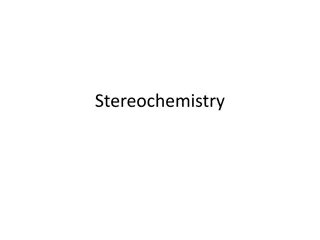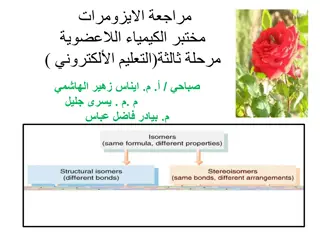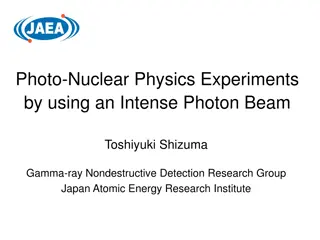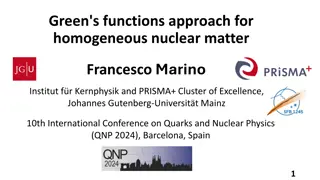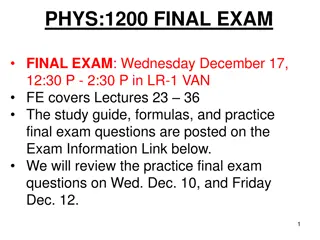Insights into Seniority Isomers in Nuclear Physics
Explore the concept of seniority isomers in nuclear physics, delving into topics like semi-magic isomers, alignment properties of intruder orbitals, and the role of seniority mixing. Discover the significance of Z=50, N=82 isomers and the structural properties associated with them. Uncover the essence of seniority as the number of unpaired nucleons and its conservation up to specific shell models.
Download Presentation

Please find below an Image/Link to download the presentation.
The content on the website is provided AS IS for your information and personal use only. It may not be sold, licensed, or shared on other websites without obtaining consent from the author.If you encounter any issues during the download, it is possible that the publisher has removed the file from their server.
You are allowed to download the files provided on this website for personal or commercial use, subject to the condition that they are used lawfully. All files are the property of their respective owners.
The content on the website is provided AS IS for your information and personal use only. It may not be sold, licensed, or shared on other websites without obtaining consent from the author.
E N D
Presentation Transcript
Semi Semi- -magic seniority isomers magic seniority isomers and and the effective interactions the effective interactions Ashok Kumar Jain Department of Physics Indian Institute of Technology, Roorkee
Outline Atlas of Nuclear Isomers ~2450 Isomers Seniority isomers: Where and why?? Semi-magic seniority isomers Similar excitation energy systematics Similar half-life systematics Will large scale shell model calculations be able to explain this?? Alignment properties of the intruder orbital Neutron-rich Sn-isomers beyond 132Sn and the effective interactions How a small change in TBME changes seniority mixing? Summary 2
Fission/ Shape isomers K- isomers Spin isomers Shape isomers 3
Lower limit of the half-life : 10 ns Total no. of isomers = 2448 Even-even = 414 Odd- odd = 800 Even-odd = 640 Odd-even = 594 4 To be published in Nuclear Data Sheets
What is seniority? In the 1940s Racah had introduced the concept in the atomic context. The third of his seminal series contains the first mention of seniority. It has been adopted in nuclear physics in a similar fashion. Seniority (v) may be defined as the number of unpaired nucleons. Particle number independent energy variation. Constant pairing gap. Any identical fermions in single-j shell conserves seniority if j 7/2. The seniority is conserved up to j=11/2 in Sn-isomers after the mid-shell, where the mixing of other orbitals is negligible. interaction between 5
Seniority isomers: Where to find and why?? Seniority: number of unpaired nucleons Semi-magic isomers : good place to find seniority isomers. E2 transitions between same seniority states vanish, when the valence shell is close to the half-filled. [Ref: A. De Shalit and I. Talmi, Nuclear Shell Theory (Dover Publications, New York, 1963). ] C.T. Zhang et al., PRC 62, 057305 6
Why Z=50, N=82 isomers?? Same spin-parity isomers 11/2 , 10+ and 27/2 Same available valence-space (50-82) Observed similar kind of systematic Half-life Excitation energies High-j h11/2 orbital plays the dominant role. Fascinating to explore their structural properties 7
Calculated and experimental excitation energies for the Z=50 isomers Energy transition ~ 4 MeV ~ 3 MeV v=4, 5 g7/2, d5/2 h11/2 v=2, 3 v=1 v=1 SN100PN: 0g7/2, 1d5/2, 0h11/2, 1d3/2, and 2s1/2 orbitals [Ref.: B. A. Brown, et al., Phys. Rev. C 71, 044317 (2005). ] 8 Nushell [Ref.: B. A. Brown and W. D. M. Rae, Nushell @MSU, MSU-NSCL report (2007). ]
Calculated and experimental excitation energies for the N=82 isomers Energy transition To be published. ~ 4 MeV ~ 3 MeV 0 g7/2, d5/2 v=4, 5 h11/2 v=2, 3 v=1 v=1 SN100PN: 0g7/2, 1d5/2, 0h11/2, 1d3/2, and 2s1/2 orbitals [Ref.: B. A. Brown, et al., Phys. Rev. C 71, 044317 (2005). ] 9
Z=50 and N=82 seniority isomers the configuration lists the unpaired neutrons in the respective orbitals. 10+ 11/2- Isotope Seniority Configuration Isotope Seniority 27/2- Seniority Configuration Configuration 102Sn 104Sn 106Sn 108Sn 110Sn 112Sn 2 4 4 2 2 2 2 h11/22 g7/22, d5/22 g7/22, d5/22 h11/22 h11/22 h11/22 h11/22 103Sn 105Sn 107Sn 109Sn 111Sn 113Sn 1 1 1 1 1 1 1 h11/21 h11/21 h11/21 h11/21 h11/21 h11/21 h11/21 3 5 5 5 5 3 3 h11/23 g7/22, d5/22, h11/21 g7/22, d5/22, h11/21 g7/22, d5/22, h11/21 g7/22, d5/22, h11/21 h11/23 h11/23 114Sn 115Sn 10+ Seniority 11/2- Seniority 27/2- Seniority Isotone Configuration Isotone Configuration Configuration 134Te 136Xe 138Ba 140Ce 142Nd 144 Sm 146Gd 2 4 4 4 4 4 2 h11/22 g7/22, d5/22 g7/22, d5/22 g7/22, d5/22 g7/22, d5/22 g7/22, d5/22 h11/22 135I 137Cs 139La 141Pr 143Pm 145Eu 147Tb 1 1 1 1 1 1 1 h11/21 h11/21 h11/21 h11/21 h11/21 h11/21 h11/21 3 5 5 5 5 5 3 h11/23 g7/22, d5/22, h11/21 g7/22, d5/22, h11/21 g7/22, d5/22, h11/21 g7/22, d5/22, h11/21 g7/22, d5/22, h11/21 h11/23 10
Single-particle energies h11/2 orbital comes late in the N=82 isomers compared to the Z=50 isomers. N=82 isomers Therefore, the change in the seniority takes place at different neutron/proton numbers in the two chains. Z=50 isomers 11
Alignment of the h11/2 orbital after the mid-shell Isotope E (2+ 0+) E (12+ 10+) Isotope E (15/2- 11/2-) E (31/2- 27/2-) R (15: 2) R (31: 12) 112 Sn 1.257 113 Sn 1.168 0.9295 Sn-isotopes 114 Sn 1.300 115 Sn 1.312 1.0089 116 Sn 1.294 117 Sn 1.279 0.9887 Expt. 118 Sn 1.230 1.237 119 Sn 1.220 1.179 0.9921 0.953 120 Sn 1.171 1.190 121 Sn 1.151 1.083 0.9827 0.910 122 Sn 1.141 1.103 123 Sn 1.107 1.043 0.9706 0.946 124 Sn 1.132 1.047 125 Sn 1.088 0.924 0.9614 0.883 Isotope E (2+ 0+) E (12+ 10+) Isotope E (15/2- 11/2-) E (31/2- 27/2-) R (15: 2) R (31: 12) 114Sn 1.508 0.878 0.988 0.939 0.888 1.093 1.123 1.197 0.853 1.12 1.007 0.905 0.822 0.937 0.919 0.977 115Sn 1.463 0.889 0.942 0.872 0.827 0.994 1.014 1.152 0.782 0.921 1.011 0.871 0.841 0.905 0.871 0.970 1.012 0.953 0.928 0.931 0.910 0.903 0.962 0.916 0.822 1.004 0.962 1.023 0.966 0.948 Theo. 116Sn 117Sn 118Sn 119Sn 120Sn 121Sn 122Sn 123Sn 124Sn 125Sn 126Sn 128Sn 127Sn 129Sn 12 ~1 value
Similar alignments in the N=82 isotones Isotone E (2+ 0+) E (12+ 10+) Isotone E (15/2- 11/2-) E (31/2- 27/2-) R (15: 2) R (31: 12) 146 Gd 2.212 0.994 147 Tb 2.152 0.920 0.972 0.925 148 Dy 1.088 1.293 149 Ho 1.182 1.501 1.086 1.160 150 Er 1.162 1.090 151 Tm 1.067 1.000 0.918 0.917 152 Yb 1.102 0.981 153 Lu 1.006 0.902 0.913 0.919 154 Hf 1.068 0.923 155 Ta 0.974 0.845 0.912 0.915 156 W 1.279 1.035 157 Re 1.135 0.878 0.887 0.848 Theo. 158 Os 1.279 1.002 ~1 value On the basis of the similar behavior in the Z=50 and the N=82 chains, we can make reliable predictions for some new isomers. 13
Z=50 and Z=82 seniority isomers coming from their respective intruder orbitals High seniority i13/2 orbital f5/2, p3/2, p1/2 and i13/2 low seniority High seniority h11/2 orbital g7/2, d5/2 and h11/2 low seniority Different intruder orbitals Mirror experimental energy systematics Will large scale scale shell model calculations be able to explain this? 14
Large scale shell model calculations Nushell[Ref.: B. A. Brown and W. D. M. Rae, Nushell @MSU, MSU-NSCL report (2007). ] SN100PN: 0g7/2, 1d5/2, 0h11/2, 1d3/2, and 2s1/2orbitals [Ref.: B. A. Brown, et al., Phys. Rev. C 71, 044317 (2005). ] To be published. KHHE:1h9/2, 2f7/2, 1i13/2, 3p3/2, 2f5/2, and 3p1/2 orbitals Warburton and B. A. Brown, Phys. Rev. C 43, 602 (1991). ] [Ref.: E. K. Our reproduce systematics quite well except for the fact that the relative gap of the isomeric states is systematically smaller due to truncations for both the chains. calculations are able to the experimental the applied 15
Neutron-rich seniority isomers beyond 132Sn and the effective interactions 136,138Sn measured for the first time. Interpretation in terms of v=2 and v=4 seniority mixing. 6+ isomer has been assigned as v=2 isomer. Simpson et al. PRL 113, 132502 (2014) 16
Simpson et al. PRL 113, 132502 (2014) Realistic Vlowk interaction does not reproduce the expt. BE2 value for 136Sn, even when the core excitations are included. A reduction of diagonal and non-diagonal f7/22 TBME by 150 keV generates a seniority- mixed 4+ state equivalent to the reduced pairing, and reproduces the expt. data. 17
6+ isomers in 134-138Sn B. Maheshwari, A. K. Jain and P. C. Srivastava, Phys. Rev. C 91, 024321 (2015) 18
How a small change in TBME changes seniority mixing? If the seniority is conserved then the BE2 should be almost zero at the mid-shell, 136Sn. Large nonzero value = Seniority mixing On modifying the interaction , BE2 increases seniority mixing increases. Active orbital: f7/2 orbital RCDBMO: modified RCDB by reducing the diagonal and non-diagonal f7/22 TBME by 25 keV. 19
Summary Data of about 2450 isomers with lower limit as 10 ns have been collected and systematized in different ways. This helps us in understanding many universal and novel features of nuclear isomers. It is interesting to observe that the semi-magic seniority isomers show identical energy and half-life systematics. Large scale shell model calculations are able to reproduce the systematics quite well. Their systematic studies provide a global understanding of the known isomers and predictions of unknown isomers. The systematic studies in long chain of isomers are also able to shed light on the nature of the effective interactions, particularly in neutron/proton-rich regions. 20
T h a n k s 21




